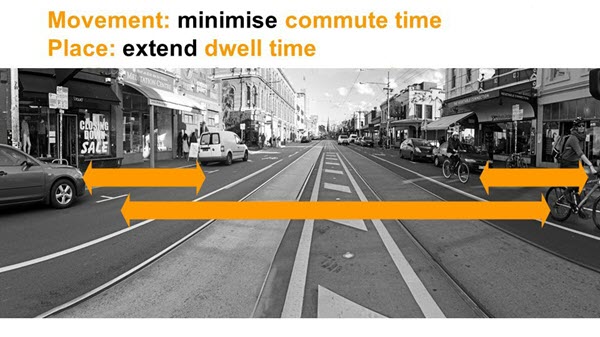Movement and Place
We've developed a smarter way to manage the increasing number of trips on our roads so that Victoria remains a great place to live.
What is Movement and Place?
Movement and Place is the Department of Transport’s new way of thinking about the roles and challenges facing our transport system now and into the future. The Movement and Place (M&P) approach recognises that transport links perform two functions: movement of people and goods and serving as a place (a destination in its own right). This way of thinking ensures that while we are planning for and developing our network, we are considering the needs for movement and placemaking simultaneously.



Figure 1: Design objectives for Movement and Place
It is important to recognise the competition between movement and place uses and decide on the balance that needs to be achieved for each of these functions at the desired locations.
What is the Movement and Place Framework?
As the next evolution of SmartRoads thinking, the M&P Framework was created by Transport for Victoria (TFV) to assist in conducting effective integrated transport planning. It is a decision-making framework that outlines the competing interests on the transport links and reports performance in terms of movement, place, environment and safety outcomes.
Why do we need Movement and Place?
Victoria is facing unprecedented population growth. Urbanisation is increasing with most of the population increase taking place in the big cities. In Melbourne, for every 10 people today there will be 16.9 people in 2051. The demand for space on our streets will be enormous and guidance will be needed to provide for the associated increase in people and goods movement, and the development of our streets to perform as places to live, shop, work and socialise.
While expansion of urban areas of Melbourne and regional cities is possible to some extent, most people will be accommodated within existing urban areas, where the widths of our streets are fixed or constrained by existing built form.
The Movement and Place Framework is used to assess these network challenges, its competing demands and helps us:
- Consider movement, place, safety and environmental outcomes when making decisions on our transport network
- translate high level strategies and plans into projects and operations
- achieve objectives from Transport Integration Act 2010
- define the way in which we understand problems, consider future needs
- create better places by supporting the design of people-friendly streets
- prioritise travel modes for different streets and contexts
- consider best outcomes for cycling, walking, and place making
- support productivity by facilitating movement of goods and people.
M&P is not prescriptive; it does not have defined outcomes with narrow objectives. Instead, it provides us with a common language to talk about transport and land-use planning with transport agencies, local government and Victorian communities. This next step in the evolution of the SmartRoads framework continues our aspiration for a holistic and integrated approach to transport decision making.
For more information, please refer to the Department of Transport’s Movement and Place information bulletin [PDF 1.98 Mb].
We recommend that you complete the Movement and Place training course if you’re using the framework in your work. For more information and to register, go to:
VicRoads & DoT accredited technical training programs